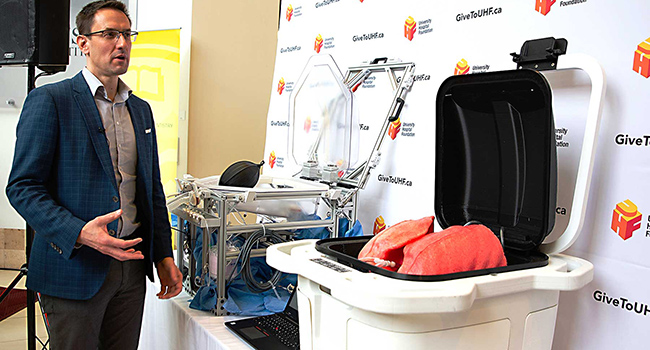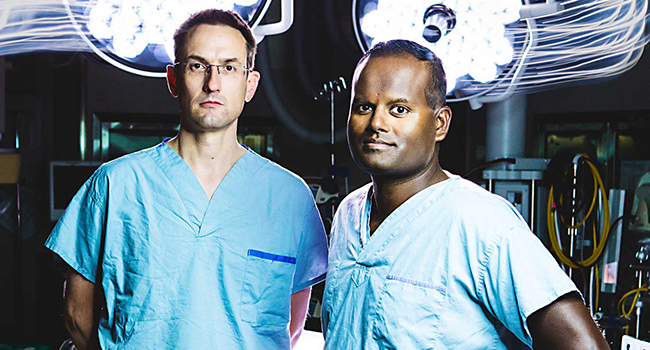
Darren Freed presents the EVOSS device that made 12 successful lung transplants possible in 2019. (Photo: University Hospital Foundation)
A University of Alberta-led trial has demonstrated the potential of the Ex-Vivo Organ Support System (EVOSS) device to increase life-saving opportunities for patients waiting for a lung transplant.
The study, published in Nature Communications, confirmed the efficacy of the device in using negative pressure ventilation ex situ lung perfusion (NPV-ESLP) to assess and reclaim donor lungs that were initially deemed unusable for transplantation based on poor lung function.
EVOSS, invented and developed by U of A medical researchers, is making strides in the mission to solve two of the biggest issues in organ transplantation – the low number of healthy organs available and the limited window of time to get a donated organ to a patient. The need for viable lungs for transplants is expected to increase in the future, due to a significant number of patients developing pulmonary fibrosis as a result of COVID-19.
U of A surgeons Darren Freed and Jayan Nagendran developed the EVOSS, a platform that uses negative-pressure ventilation to replicate the way our chest cavity expands and contracts with each breath. By mimicking the natural process of breathing, it ventilates donated lungs in an ex vivo (“out of the living”) organ perfusion device, which constantly supplies the lungs with blood and oxygen and keeps them warm, similar to the conditions inside the body.
Freed, director of research for the Alberta Transplant Institute, said the negative pressure model has been shown to reduce injuries to the lungs and improve the ability to repair damage. It may also lead to an increase in the number and quality of organs available for transplant.
Currently, organs are stored on ice while being transported, which often results in organ damage. The only thing physicians can do to minimize the risk of damage is reduce the time between when the organ is harvested and when it is transplanted.
Lungs can be kept from six to eight hours on ice, but up to 48 hours on the EVOSS device. This additional time also allows for organs to be assessed and repaired, which increases the number of viable organs available.

Surgery professors Darren Freed (left) and Jayan Nagendran developed the EVOSS device, which can keep donated lungs viable for up to six times longer than storing them in ice before transplant. (Photo: Laughing Dog Photography)
According to Freed, the idea of continuous perfusion of organs for transplantation isn’t a new one, but in the last 10 to 15 years there has been a push to improve organ preservation rates.
“The U of A has a very large transplant volume, and there is a very strong transplant science academic community here,” said Freed. “The science of ex vivo perfusion is still in its infancy in a lot of ways, so we need to continue to study and be diligent, which is why multidisciplinary research like what we do here is so critical to realizing the full potential of ex vivo organ donation.”
The research team is also working on inserting this technology into portable devices capable of transporting any type of donated organ.
“Not only is it an opportunity to improve the quality of donor organs around the world, but it’s an Alberta-specific problem that we are addressing due to our unique geography,” said Nagendran, director of research for the U of A’s Division of Cardiac Surgery and surgical director of lung transplantation for the University of Alberta Hospital.
The University of Alberta Hospital has the largest geographic catchment area in the world for a single transplant centre, covering more than six million square km.
“We are frequently facing difficulties because an organ has been out of the body for a long time, in spite of trying to get it here as soon as possible,” said Nagendran, who performed the first ex vivo perfusion lung transplant in Alberta in 2013 and brought the first portable ex vivo lung perfusion device to the U of A as part of a worldwide clinical trial. “It’s one of the reasons why innovation is at the heart of what we do in Edmonton.”
“I don’t think that it’s a stretch to say that the future of transplantation is ex vivo organ perfusion,” said Freed. “There will be a time in the near future when 90 per cent of all organs are transplanted having been perfused out of the body.”
The EVOSS project was possible thanks to an investment of more than $1 million from the University Hospital Foundation and Alberta Transplant Innovation Fund (ATIF), a partnership between the government of Alberta Ministry of Jobs, Economy and Innovation, Astellas Pharma Canada Inc., and the University Hospital Foundation. The research was additionally supported through the Canadian Donation and Transplantation Research Program and the Alberta Transplant Institute, both led out of the U of A.
| By Laura Vega, with files from Shelby Soke
Laura Vega is a reporter with the University of Alberta’s Folio online magazine. The University of Alberta is a Troy Media Editorial Content Provider Partner.
The opinions expressed by our columnists and contributors are theirs alone and do not inherently or expressly reflect the views of our publication.
© Troy Media
Troy Media is an editorial content provider to media outlets and its own hosted community news outlets across Canada.


